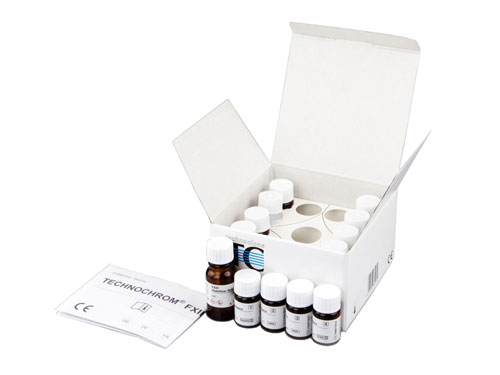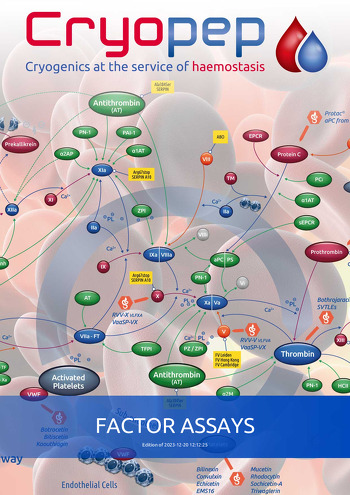HEMOSTASIS COAGULATION ROUTINE REAGENTS FACTOR ASSAYS CHROMOGENIC ASSAYS FACTOR XIII
TECHNOCHROM® FXIII
Assay kit for the detection of congenital or acquired FXIII deficiencies, abnormal levels with low activity or high FXIII levels.
TECHNOCHROM® FXIII is a chromogenic enzymatic assay kit for determining the activity of FXIII.
Method / Application
The determination of the activity of FXIII is based on the measurement of the ammonia released during the transglutaminase reaction. FXIII present in plasma is activated in the presence of thrombin and calcium.
The polymerization of fibrin is prevented and therefore the FXIIIa will catalyze the transformation of an amino substrate of glycine ethyl ester (GEE) into a glutamine residue and releasing an ammonium ion.
The amount of ammonium ion released is followed by a reaction dependent on NADPH, followed by the spectrophotometer with a decrease in absorbance at 340 nm
Informations
FXIII or fibrin stabilization factor is the zymogen of a transglutaminase. FXIII is activated by thrombin, it intervenes in the final phase of fibrinoformation to stabilize the fibrin clot. It is also involved in the phenomena of tissue repair and scarring by allowing the association of collagen and fibronectin.
There are constitutional deficits in FXIII which are autosomal recessive inheritance. The severe forms are associated with a hemorrhagic syndrome. Acquired FXIII deficiency due to anti-FXIII autoantibodies is also a very important cause of bleeding diathesis.
The consumption of FXIII in various diseases (malignant infections, Crohn's disease, Henoch-Schoenlein purpura, major surgery, ...) usually results from a moderate drop in the level of FXIII.
Documentation
Download the product sheetPrice list, safety data sheets and notices are accessible to our registered customers.

Colorimetric assay








References
| 4-5360010 | Kit | 3 x 20 tests |

















